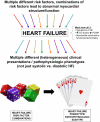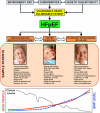Phenotypic spectrum of heart failure with preserved ejection fraction
- PMID: 24975905
- PMCID: PMC4076705
- DOI: 10.1016/j.hfc.2014.04.008
Phenotypic spectrum of heart failure with preserved ejection fraction
Abstract
Heart failure with preserved ejection fraction (HFpEF) is a heterogeneous syndrome, with several underlying etiologic and pathophysiologic factors. The heterogeneity of the HFpEF syndrome may explain why (1) diagnosing and treating HFpEF is so challenging and (2) clinical trials in HFpEF have failed thus far. Here we describe 4 ways of categorizing HFpEF based on pathophysiology, clinical/etiologic subtype, type of clinical presentation, and quantitative phenomics (phenomapping analysis). Regardless of the classification method used, improved phenotypic characterization of HFpEF, and matching targeted therapies with specific HFpEF subtypes, will be a critical step towards improving outcomes in this increasingly prevalent syndrome.
Keywords: Classification; Clinical trials; Etiology; Heart failure with preserved ejection fraction; Pathophysiology; Phenomics; Phenotype.
Copyright © 2014 Elsevier Inc. All rights reserved.
Figures








References
-
- Yancy CW, Jessup M, Bozkurt B, et al. 2013 ACCF/AHA Guideline for the Management of Heart Failure: A Report of the American College of Cardiology Foundation/American Heart Association Task Force on Practice Guidelines. J Am Coll Cardiol. 2013 - PubMed
-
- Shah AM, Pfeffer MA. The many faces of heart failure with preserved ejection fraction. Nat Rev Cardiol. 2012;9(10):555–556. - PubMed
Publication types
MeSH terms
Substances
Grants and funding
LinkOut - more resources
Full Text Sources
Other Literature Sources
Medical

